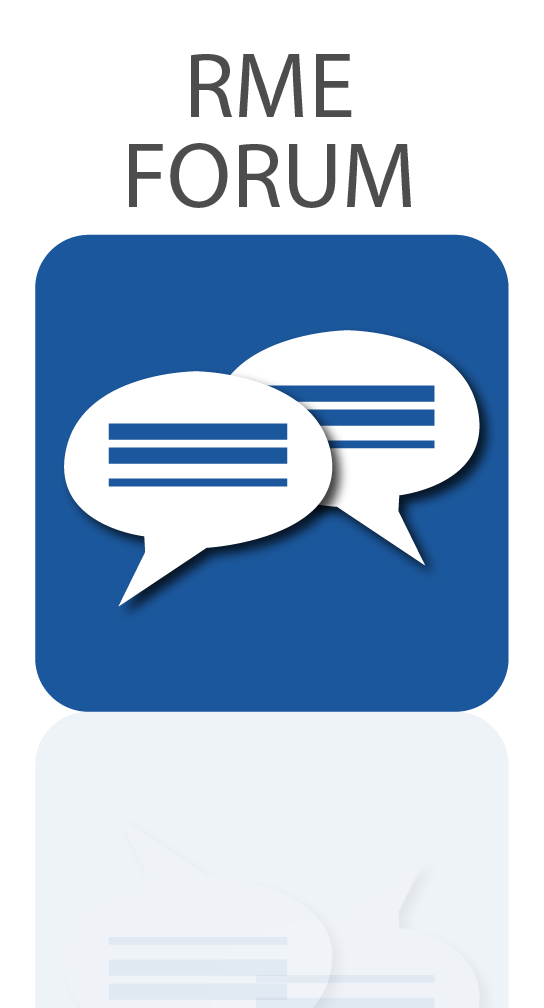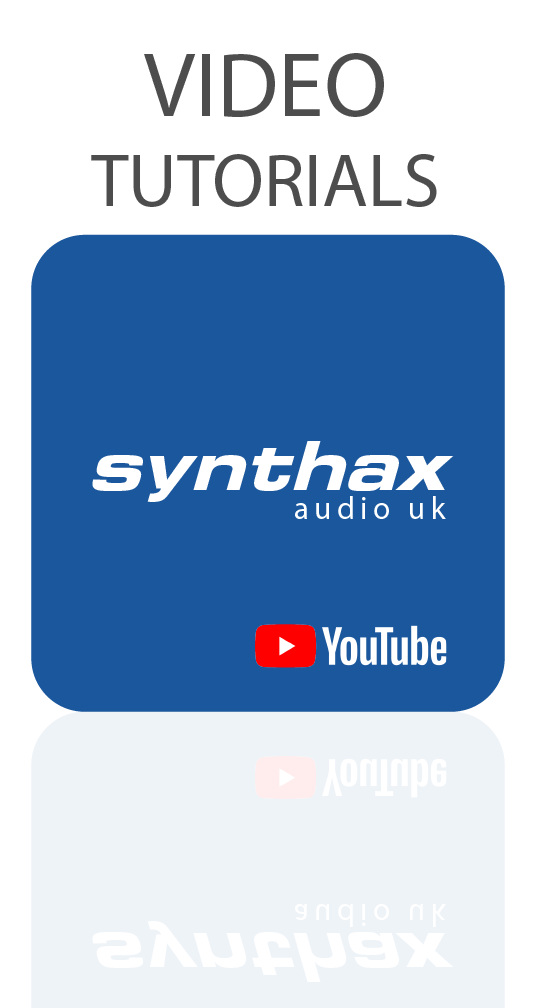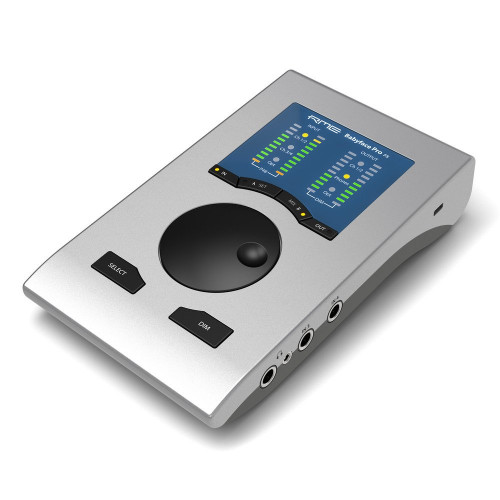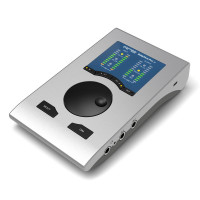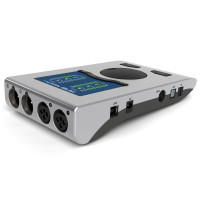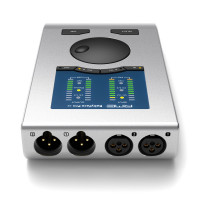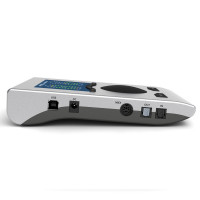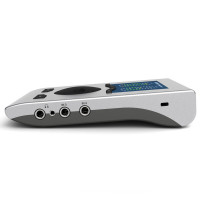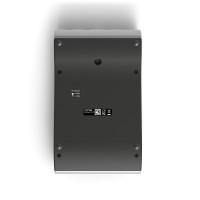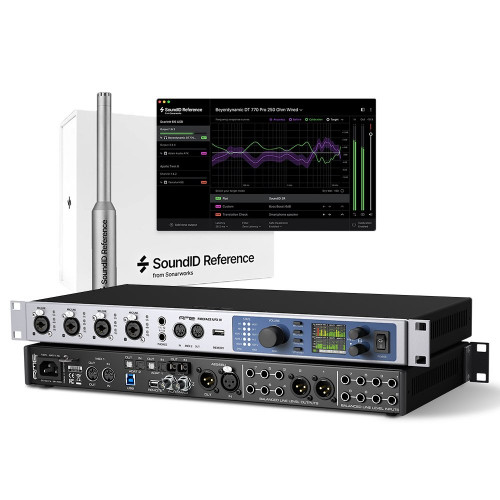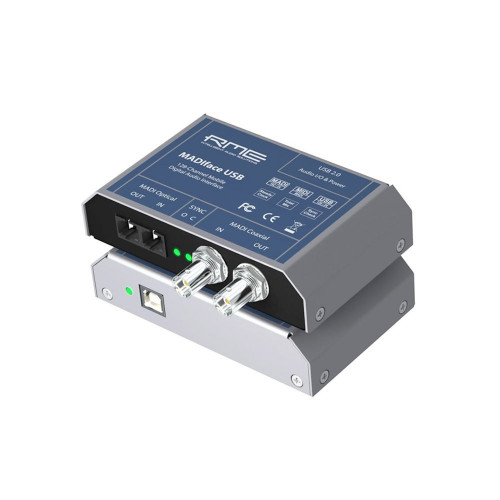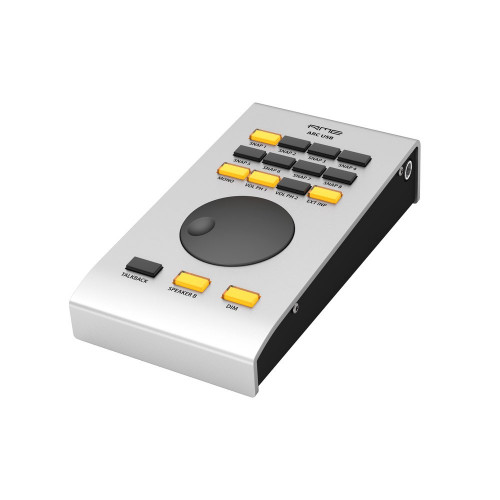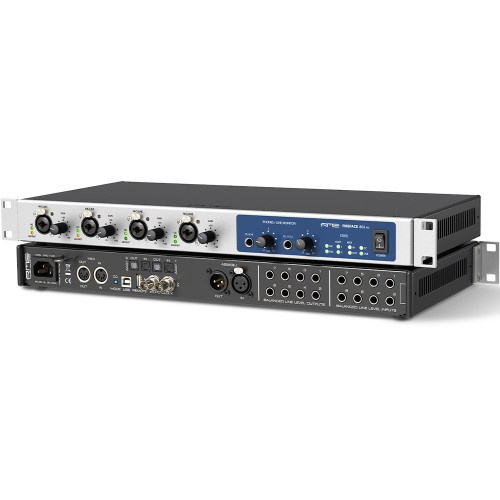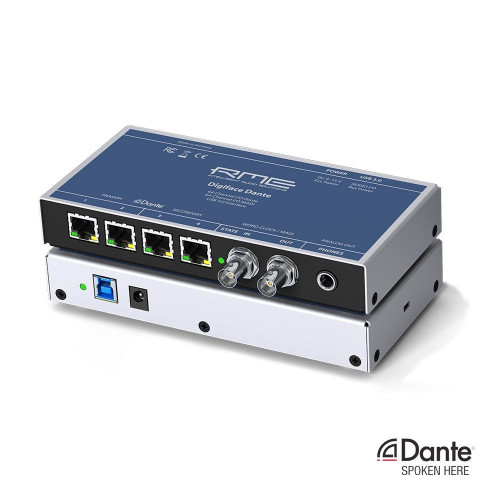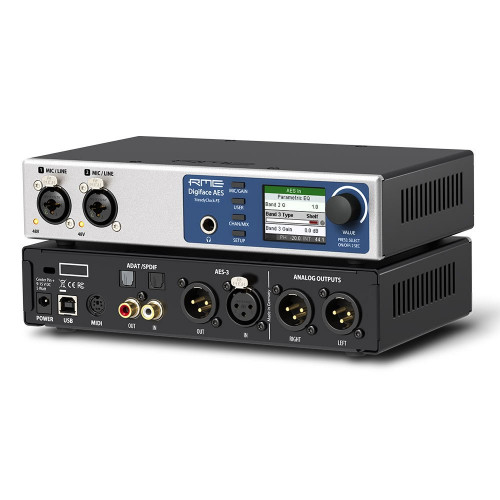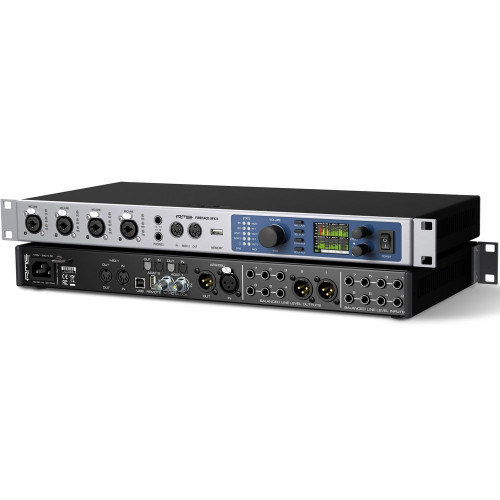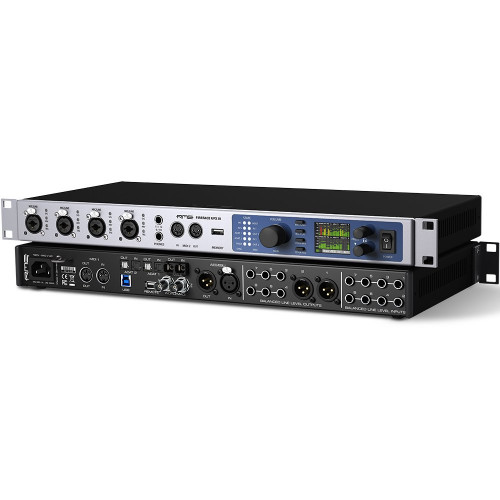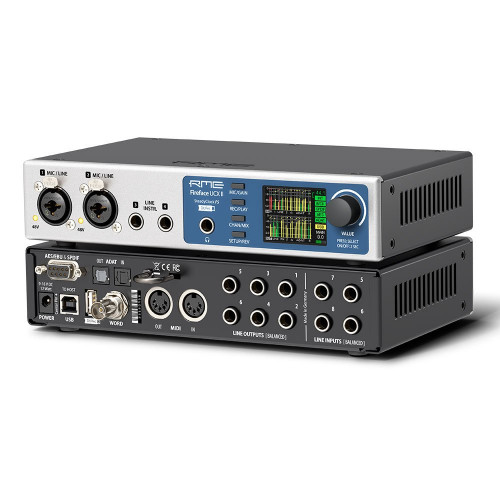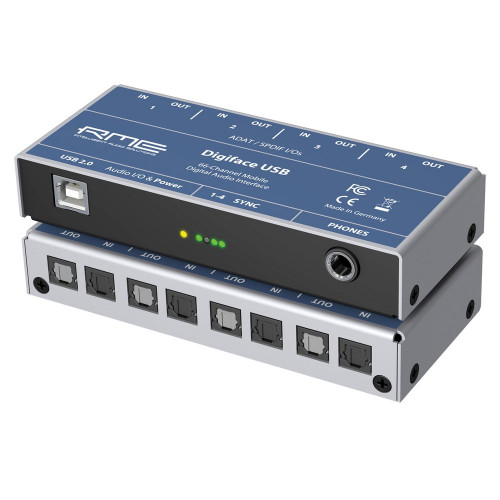RME Babyface Pro FS
24-Channel, 192 kHz Bus-Powered,
Professional USB Audio Interface
- Second generation update to the RME Babyface Pro
- Same great looks, even better sound!
- Femtosecond ('FS') clocking technology (also found on the high-end ADI-2 Series)
- Improved preamps
- Improved headphone amps
- Even better latency
- Physical switch (+19/+4 dBu) for direct adjustment of output levels
- TotalMix FX
- TotalMix Remote
- Kensington Lock connection
- 5 Year Warranty (UK Only)
Connectivity
- 4 x Analogue Inputs (Mic / Line / Instrument)
- 4 x Analogue Outputs (2 x XLR, 2 x Phones)
- 1 x ADAT I/O or 1 x SPDIF I/O optical
- 1 x MIDI I/O
Description
Professional High-Precision Audio Interface
In 2015, the Babyface Pro again demonstrated RME’s absolute commitment to superior craftsmanship in audio circuit design, driver development and mechanics. Created with the highest precision from a block of aluminium, this high-end portable interface incorporated newly designed analogue and digital circuits, with innovative energy-saving technologies providing supreme fidelity without compromising in level, noise or distortion.
More Pro-level Performance with SteadyClock FS
The clock frequency is an essential factor in digital audio, creating the correlation between the audio bits and time reference. Unfortunately for many devices, the clock frequency is not always as stable as desired. The Babyface Pro FS offers the full SteadyClock FS circuit, as found on RME's award-winning ADI-2 Pro FS AD/DA converter, and resulting in incredibly low jitter values and highest jitter immunity.
All clock modes provide excellent performance and astonishingly high-quality analogue conversion, allowing you to hear your mix exactly as it is. What's more, RME's digital format conversion occurs without any loss to the signal, and SteadyClock FS ensures your sonic image will never experience any kind of degradation. This helps to optimize recordings and mixes, ensuring the soundstage is replicated to the fullest depth and clarity.

Click image to enlarge
Award-Winning ADI-2 Series Headphone Power
The two headphone outputs offer direct connections for TRS (1/4 " / 6.3 mm) and mini-jack (1/8 " / 3.5 mm) sockets in parallel.
Completely separate driver stages perfectly match with low and high impedance headphones, guaranteeing pristine sonic results regardless of the headphone used.
The Babyface Pro FS features the same output op-amps found on the RME ADI-2 Pro FS, increasing the headphones output power to 90 mW.
The THD (total harmonic distortion) of both phones outputs has also improved by up to 10 dB, with the 3.5 mm connection's output impedance lowered from 2 Ohms to 0.1 Ohms.
Full range capture - Improved Mic & Line Input
Two digitally controlled preamps provide individually switchable 48V phantom power. These improved new circuits feature a gain range of 76 dB, adjustable in steps of 1 dB, including a relay-driven PAD, resulting in exceptional EIN (Equivalent Input Noise) performance as well as line overload protection, and enough gain for even the lowest level microphones.
For the main I/O RME have designed an XLR socket which integrates seamlessly into the housing. The comprehensive feature set continues with an optical TOSLINK I/O; use as either an ADAT port with SMUX support or SPDIF for sessions up to 192 kHz.
In combination with an external ADAT converter, the Babyface Pro FS fully supports 12 analogue inputs as well as 12 outputs, making it ideal for both live and studio multi-track applications.
Two balanced line inputs allow you to plug in any instrument, either line-level or high impedance, for recording with the Babyface Pro FS. Record your guitar on the go, with no additional hardware required.
The package is completed with MIDI I/O, accessible via the included breakout cable.

A touring musician's dream...
The Babyface Pro FS's user interface is both informative and clearly laid out, providing simple and intuitive access to every feature and configuration mode. Even in standalone mode, routing and mixing of inputs to outputs is possible directly from the front-panel controls, opening up a whole world of possible applications.
The Babyface Pro FS’s incredibly efficient design almost never requires an external power supply when used with computers – it’s perfectly stable on USB 3 bus power, and also most USB 2 ports, with no degradation in any technical specification. This makes it perfect for mobile recording, even with a pair of your favourite condenser microphones simultaneously using 48v phantom power.
All of these new improvements were achieved without raising the power consumption of the unit, and offers fully bus-powered performance.
Class Compliant Mode (Plug 'n' Play)
The Babyface Pro FS also features a Class Compliant / Plug 'n' Play
mode, enabling the interface to be used for high-quality, mulit-track
recording with an Apple iPad, and providing iPad users with a full set
of professional analogue I/O connections.
Additionally, the optional TotalMix FX for iPad app adds full control over the Total Mix hardware mixer, giving users the ability to create, store and load complete mixes directly from the iPad.
RME Babyface Pro FS - Unboxing Video
TotalMix FX & TotalMix Remote - The most powerful monitoring and mixing controller available

TotalMix FX
Like all the latest RME interfaces, the Babyface Pro FS includes the powerful digital real-time mixer TotalMix FX.
The DSP-based TotalMix mixer allows for fully independent routing and mixing of all audio channels, essentially turning the RME Babyface Pro FS into a full-blown digital mixing console (complete with independent 3-Band parametric EQ on every channel, plus Reverb and Delay effects sends).
Independent stereo submixes plus a comprehensive Control Room section offer unrivalled monitoring capabilities and routing flexibility from an audio interface, matching the features found on high-end digital consoles.
For a more detailed introduction to TotalMix FX, see the TotalMix FX for Beginners series of YouTube Videos.
TotalMix Remote
TotalMix Remote is a free companion app for TotalMix FX, and enables remote control of RME audio interfaces over any standard IP based network.
With TotalMix Remote activated, the Babyface Pro FS's TotalMix FX software controller can be managed directly from another computer on the same network, including over Wi-Fi. You can even use an Apple iPad for wireless touch-screen control, from anywhere in a studio or venue.
Whether you're looking to mix from a remote location, provide musicians with the ability to control their individual monitor mixes, or simply need a separate display for metering, TotalMix Remote opens up a world of new possibilities.
TotalMix Remote is available to download (under the Software tab) from the RME website.
RME USB - Lowest latency performance and industry-leading stability
With each new product release, RME continues to focus on developing and optimising the core technologies found at the heart of their designs. Having paved the way for multichannel digital audio recording with a computer (with their range of professional PCI soundcards), RMe was also the first to ensure reliable, professional performance over USB 2.0 - one of many firsts for a company that has remained at the forefront of cutting-edge audio technologies since its inception.
As such, a high level of attention continues to be placed on developing reliable, stable, and regularly updated drivers for all products, alongside the unwavering focus on audio quality.
This guarantees your Babyface Pro FS will never be outdated, and always updated.
And because RME Audio develops its own interface core, RME devices are never dependent on 3rd parties for upgrades, modifications or bug fixes, giving users the opporunity to use the latest operating systems without interruption or delay.
Comparison: Improvements over the original Babyface Pro
• Full SteadyClock FS circuit as in the ADI-2 Pro FS for lowest jitter and highest jitter immunity.
• 3.5 mm TRS phones output power rises from 70 mW to 90 mW. THD of both phones outputs improved by up to 10 dB. Uses same output op-amps as ADI-2 Pro now. Output impedance of 3.5 mm TRS lowered from 2 Ohms to 0.1 Ohms.
• Mic inputs SNR improved from 112.2 dB to 113.7 dB, TRS Line inputs SNR improved from 114 dB to 116.3 dB (120 dBA). THD Line inputs improved by 8 dB.
• 6 samples less latency on the AD side by new ADC (5 samples AD, 7 samples DA. It won't get quicker...).
• New +19 / +4 dBu switch (on the bottom of the Babyface Pro FS) adds a direct way to reduce the output level, thus improving SNR for sensitive active monitors; avoiding distortion / overloads; and helping to keep TotalMix FX faders near 0 dB, instead of high attenuations.
• All the above improvements were achieved without raising the power consumption!
• K-slot (Kensington Lock) for theft protection.
Included Accessories
- Hard Plastic Storage Case
- MIDI Breakout Cable
- USB Cable (with right-angle connector)
- Paper Manual
- Driver installation CD*
*Please note: we always recommend you download the latest drivers from the RME website
Specifications
Analogue
AD, Microphone/Line 1-2
- Input: XLR, electronically balanced
- Input impedance balanced: 2 kOhm, 5.2 kOhm with PAD
- Input impedance unbalanced: 1 kOhm, 2.6 kOhm with PAD
- Signal to Noise ratio (SNR): 113,7 dB RMS unweighted, 117 dBA
- Frequency response @ 44.1 kHz, -0.1 dB: 18 Hz – 20.8 kHz
- Frequency response @ 96 kHz, -0.5 dB: 7 Hz – 45.8 kHz
- Frequency response @ 192 kHz, -1 dB: 5 Hz – 88 kHz
- With PAD active : -0.1 dB 8 Hz, -0.5 dB < 4 Hz, -1 dB < 3 Hz
- THD: < -112 dB, < 0.00024 %
- THD+N: < -108 dB, < 0.00035 %
- THD @ 30 dB Gain: < -115 dB, < 0.00016 %
- THD+N @ 30 dB Gain: < -100 dB, < 0.001 %
- Channel separation: > 110 dB
- Gain range: -11 dB up to +65 dB
- Maximum input level XLR, Gain 0 dB: +8 dBu, PAD +19 dBu
- Maximum input level XLR, Gain 65 dB: -57 dBu, PAD -46 dBu
AD, Line/Instrument In 3-4
As Microphone/Line 1-2, but:
- Input: 6.3 mm TS jack, unbalanced
- Input impedance: 1 MOhm
- Signal to Noise ratio (SNR): 116 dB RMS unweighted, 120 dBA
- Frequency response @ 44.1 kHz, -0.1 dB: 5 Hz – 20.8 kHz
- Frequency response @ 96 kHz, -0.5 dB: < 3 Hz – 45.8 kHz
- Frequency response @ 192 kHz, -1 dB: < 2 Hz – 92 kHz
- Maximum input level @+4 dBu, Gain 0 dB: +13 dBu
- Maximum input level @-10 dBV, Gain 9 dB: -5 dBu
DA, Line Out 1-2
- Dynamic range (DR): 115 dB RMS unweighted, 118 dBA
- Frequency response @ 44.1 kHz, -0.5 dB: 0 Hz – 20.8 kHz
- Frequency response @ 96 kHz, -0.5 dB: 0 Hz – 45 kHz
- Frequency response @ 192 kHz, -1 dB: 0 Hz - 89 kHz
- THD: - 106 dB, 0.0005 %
- THD+N: -102 dB, 0.0008 %
- Channel separation: > 110 dB
- Output: XLR balanced
- Output impedance: 300 Ohm balanced, 150 Ohm unbalanced
- Output level @ 0 dBFS: Balanced +19 / +4 dBu, unbalanced +13 / +7 dBu
- DC @ 0 dBFS: 6.35mm 4.8 V, 3.5mm 2.4 V, XLR bal. 9.6 V
DA, Phones 3/4
As DA Line Out, but:
- Output: 6.3 mm TRS jack, unbalanced
- Output impedance: 10 Ohm
- Output level at 0 dBFS, 1 kOhm load: +13 dBu
- Max power @ 0.1% THD: 60 mW
- Signal to Noise ratio (SNR): 114.8 dB RMS unweighted, 118 dBA
- Noise level: -101.8 dBu
- Output: 3.5 mm TRS jack, unbalanced
- Output impedance: 0.1 Ohm
- Output level at 0 dBFS, 1 kOhm load: +7 dBu
- Max power @ 0.1% THD: 90 mW
- Signal to Noise ratio (SNR): 114 dB RMS unweighted, 117 dBA
- Noise level: -107 dBu
MIDI
- 1 x MIDI I/O via breakout cable with 2 x 5-pin DIN jacks
- Galvanically isolated by optocoupled input
- Hi-speed mode: Jitter and response time typically below 1 ms
- Separate 128 byte FIFOs for input and output 25.3
Digital
- Clocks: Internal, ADAT In, SPDIF In
- Jitter suppression of external clocks: > 50 dB (2.4 kHz)
- Effective clock jitter influence on AD and DA conversion: near zero
- PLL ensures zero dropout, even at more than 100 ns jitter
- Digital Bitclock PLL for trouble-free varispeed ADAT operation
- Supported sample rates: 28 kHz up to 200 kHz
Digital Inputs
ADAT Optical
- 1 x TOSLINK
- Standard: 8 channels 24 bit, up to 48 kHz
- Double Speed (S/MUX): 4 channels 24 bit 96 kHz
- Quad Speed (S/MUX4) : 2 channels 24 bit 192 kHz
- Bitclock PLL ensures perfect synchronisation even in varispeed operation
- Lock Range: 31.5 kHz – 50 kHz
- Jitter suppression: > 50 dB (2.4 kHz)
SPDIF optical
- 1 x optical, according to IEC 60958
- Accepts Consumer and Professional format
- Lock Range: 27 kHz – 200 kHz
- Jitter suppression: > 50 dB (2.4 kHz)
Digital Outputs
ADAT optical
- 1 x TOSLINK
- Standard: 8 channels 24 bit, up to 48 kHz
- Double Speed (S/MUX): 4 channels 24 bit 96 kHz
- Quad Speed (S/MUX4) : 2 channels 24 bit 192 kHz
SPDIF optical
- 1 x optical, according to IEC 60958
- Format Consumer (SPDIF) according to IEC 60958
- Sample rate 28 kHz up to 200 kHz
General
- Power supply: USB bus power or external power supply
- Idle power consumption: 2.8 Watts
- Typical power consumption: 3.7 Watts
- Max. power consumption: 5.4 Watts
- Current at 5 V bus power operation: 700 mA (3.7 Watts)
- Current at 12 V external power: 313 mA (3.7 Watts)
- Dimensions (WxHxD): 108 x 35 x 181 mm (4.25" x 1.4" x 7.1")
- Weight: 680 g ( 1.5 lbs)
- Temperature range: +5° up to +50° Celsius (41° F up to 122°F)
- Relative humidity: < 75%, non condensing
Customer Reviews
This item currently has no reviews.



















